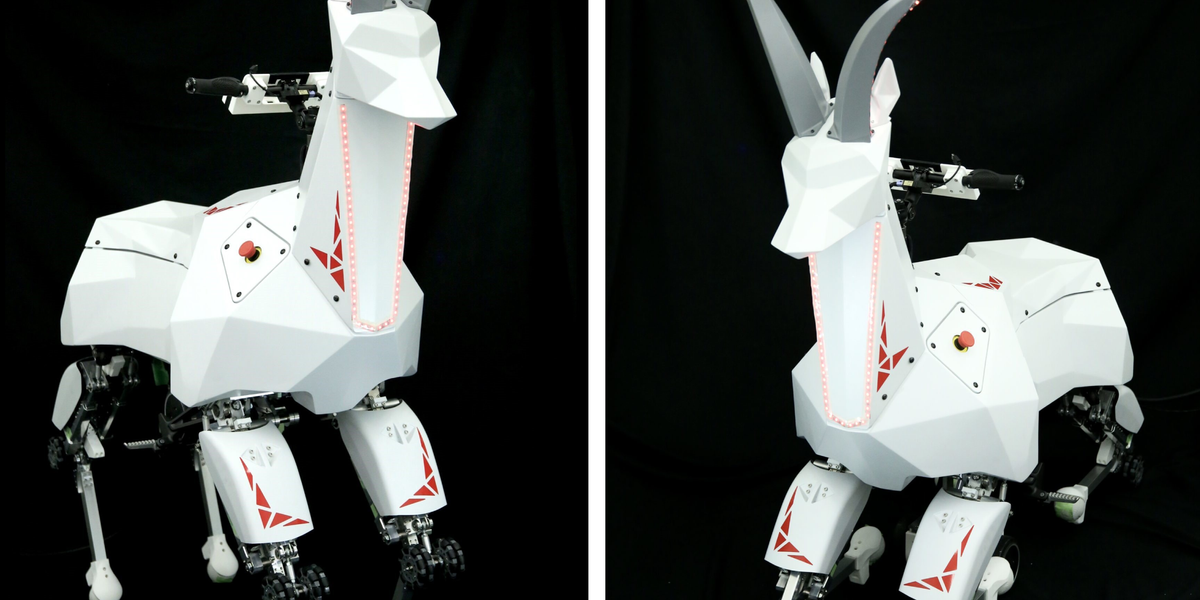Kawasaki’s Robot Ibex: Can It Be Tamed?

This is Bex. It is, as near as I can tell, a robotic ibex, designed by Kawasaki and inspired by the fiercely horny species of goat native to many mountainous regions of Africa and Eurasia. Bex made its first appearance at iREX this week in Japan, and we should talk about why a Kawasaki robot ibex now exists, besides, of course, the simple fact that it's just so darn fun to say out loud.
Kawasaki has been working on a Robust Humanoid Platform" (RHP) called Kaleido since 2015, and Bex is a friend" of that program. Masayuki Soube, who is in charge of development of the RHP, was interviewed recently on Kawasaki Robotics' website about the Bex program. The conversation was conducted in Japanese. What follows (in italics) are Google Translate's best attempts at rendering Soube's observations into workable English:
Through the development of Kaleido, we felt the difficulty of biped robots. Because humanoid robots have the same shape as humans, they are highly versatile, with the potential to do everything that humans can ultimately do. However, it will take a long time to put it to practical use. On the other hand, we are also developing a self-propelled service robot that moves on wheels, but legs are still suitable for moving on rough terrain rather than wheels. So, halfway between humanoid robots and wheeled robots, [we] wondered if there was an opportunity. That's why we started developing Bex, a quadruped walking robot. We believe that the walking technology cultivated in the development of humanoid robots can definitely be applied to quadruped walking robots.
It's worth noting that Bex appears to have a hybrid mobility system, with knee wheels that it can kneel on to move more quickly on smooth and level surfaces. It's also worth noting that Bex has a seat and handlebars (!), and it can carry up to 100 kilograms.
Rather than committing Bex to human hauling, Kawasaki had sadly settled on more practical applications, according to Masayuki Soube:
First of all, Bex can carry light cargo, such as transporting materials at a construction site. The other application is inspection. In a vast industrial plant, Bex can look around and images from its camera can be remotely checked to see what the instruments are doing. Bex can also carry crops harvested by humans on farmland.
Although the base of Bex is a legged robot, the upper body of Bex is not fixed and we are thinking of adapting it according to the application. If it is a construction site, we will form a partnership with the construction manufacturer, and if it is a plant, we will form a partnership with the plant manufacturer and leave the upper body to us. Kawasaki Heavy Industries will focus on the four legs of the lower body and want to provide it as an open innovation platform.
 Bex under development at Kawasaki RoboticsKawasaki Robotics
Bex under development at Kawasaki RoboticsKawasaki Robotics
Kawasaki is certainly not the first company to be thinking about quadrupedal robots as inspection platforms. It's also not the first to work on hybrid mobility for quadrupeds; in fact, I'm betting that Bex would have a lot of (literal) catching up to do in that space. But the idea of a quadrupedal cargo system is somewhat interesting-most quadrupeds consider cargo in terms of what useful payload they can carry, and typically those payloads are engineered around things like sensors, which don't weigh all that much. Could Bex bring us back to the days of Boston Dynamics' BigDog and LS3, where quadrupedal cargo haulers took a run at practicality? It would take a lot of work, but boy do I hope so. Big, powerful quadrupeds are super cool, especially if they have horns.